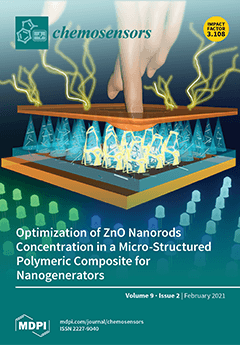Herein, a feasible chemical reduction method followed by intensive mixing was applied for the preparation of an attractive material based on graphite studded with cuprous oxide nanoparticle-based cubes (Cu
2ONPs–C@G). Transmission electron microscope (TEM), scanning electron microscope (SEM), X-ray diffraction (XRD) and
[...] Read more.
Herein, a feasible chemical reduction method followed by intensive mixing was applied for the preparation of an attractive material based on graphite studded with cuprous oxide nanoparticle-based cubes (Cu
2ONPs–C@G). Transmission electron microscope (TEM), scanning electron microscope (SEM), X-ray diffraction (XRD) and cyclic voltammetry (CV) were utilized for characterization. Cuprous oxide nanoparticles (Cu
2ONPs), with a diameter range mainly distributed from 4 to 20 nm, aggregate to form microcubes (Cu
2ONPs–C) with an average diameter of about 367 nm. Paste electrode was prepared using Cu
2ONPs–C@G (Cu
2ONPs–C@G/PE) for voltametric quantification of the musculotropic antispasmodic drug: mebeverine hydrochloride (MEB). The electrochemical behavior of MEB was studied using CV, and the optimum analytical parameters were investigated using square wave adsorptive anodic stripping voltammetry (SWAdASV). Moreover, density functional theory (DFT) was used to emphasize the ability of MEB to form a complex with Cu
2+, confirming the suggested electrochemical behavior of MEB at Cu
2ONPs–C@G/PE. With good stability and high reproducibility, SWAdASV of Cu
2ONPs–C@G/PE shows successful quantification of MEB over the concentration range of 5.00 × 10
−11–1.10 × 10
−9 M with lower limit of detection (LOD) and lower limit of quantification (LOQ) values of 2.41 × 10
−11 M and 8.05 × 10
−11 M, respectively. Finally, accurate quantification of MEB in dosage forms (tablets) and biological fluids (spiked human urine and plasma samples) was achieved using Cu
2ONPs-C@G/PE.
Full article





